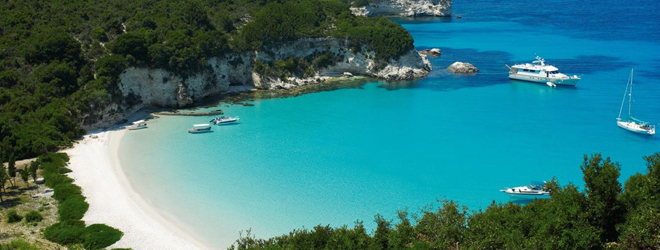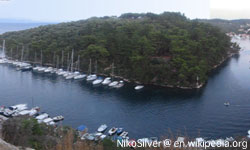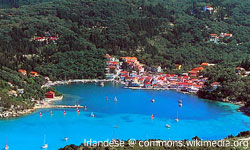
Paxos
Paxos
The Ionian islands are a group of islands to the west of mainland Greece, each with its own distinct character, and each bearing testimony to the various colonisations and historical influences of its numerous rulers. According to legend, Paxos rose from the Ionian sea at the command of Poseidon, to provide a meeting place for him and his mistress Amfitrite.
Paxos lies 14 km south of Corfu, has no airport, and can only be reached by boat. The islands of Paxos and Antipaxos and some smaller islands are together known as Paxi or Paxoi, and literally means “a group of islands”. The history of Paxos is closely linked with that of Corfu, and it is traditionally believed that the Phoenicians were the first people to settle on Paxos. Approximately 2 700 people live on Paxos today; the population of Antipaxos is a mere 100.
Still an agricultural and fishing community

Paxos is one of the least commercial of the Greek islands – its capital is Gaios, a small but lively resort town, and several other farming and fishing villages are dotted around the green landscape.
The olive groves that cover Paxos were planted centuries ago by the Venetians and the local olive oil is of an extremely high quality.
Olive farming still forms a large part of the island’s economy. One main road runs around the island and the best way to get about is by bicycle or moped. Bicycles, scooters and motorbikes can be hired in Gaios. There is also plenty of opportunity for exploring the island on foot, or hiking along the cliffs or through the woods.
Places of interest
There are more than 60 Greek Orthodox churches on Paxos, although only about 10 of these are open on a regular basis. A statue of Pyropolitic, hero of the Greek revolution, faces the waterfront in Gaios. There is a harbour for the ferries, hydrofoils and sea taxis bringing visitors from Corfu, and a smaller one for fishing boats, protected by the small islands of Agios Nikolas and Panagia.
The Paxos Museum, on the harbour side of Gaios, was opened in 1996, and houses artefacts such as old olive presses and containers for measuring oil, stone-age flint tools, pottery from the Classical period, as well as guns and tools from later eras. Gaios has the only nightclub on the island.
An abundance of coastal beauty

There are in excess of 30 beautiful beaches along the east coast of Paxos. The smallest and most attractive of these is the resort of Porto Longos. It has a pebble beach, a few shops, and tavernas whose tables stand on the water’s edge.
The village of Lakka, on the northern tip of Paxos, also has two pristine beaches and watersport is on offer. The west coast of Paxos, with its soaring white limestone cliffs and huge caves is spectacularly beautiful. Because of its inaccessibility, the stunning beaches are best reached by boat. A motorboat can be hired to explore the beaches and coastal villages of Paxos.
Antipaxos also has olive groves, but even more vines, and produces good-quality wine. There is no tourist accommodation, but it is a 15-minute journey by sea taxi and day trippers from Paxos enjoy its beaches in summer.
Accommodation
The Paxos Beach Hotel and the Paxos Club are both 4-star, family run hotels – the Paxos Beach Hotel offers sea views and the facilities include a private beach.